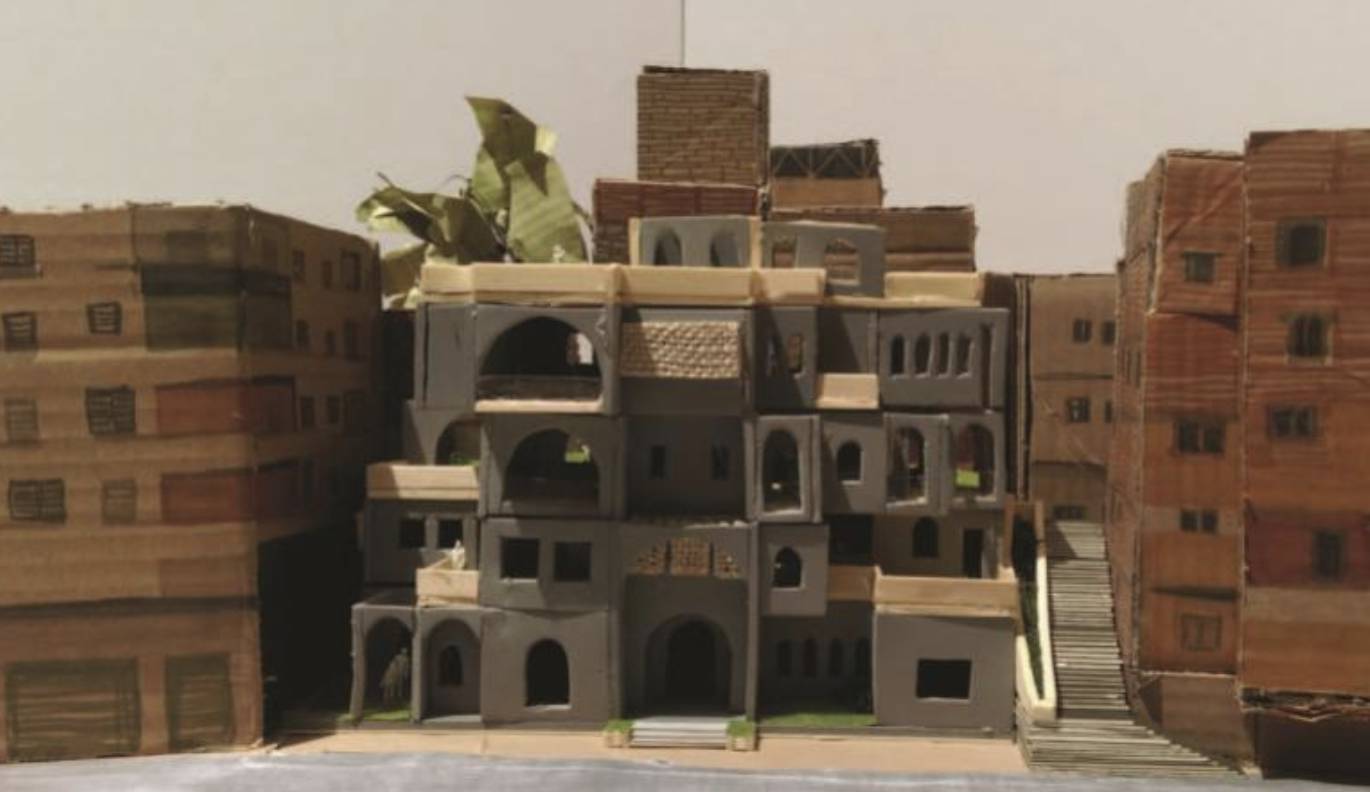
As part of AUC’s Cairo in the Curriculum initiative, architecture students in the Design Studio II class, taught by Magda Mostafa, associate professor of architecture, took part in the project, Made in Egypt, visiting assigned sites in Cairo, making observations, engaging with community members and discussing their findings in class while integrating assigned readings and individual research. Incorporating Cairo into the academic experience and breaking the barriers between classroom and city, the students created physical models and drawings of a learning center and a community center in Cairo.
“Some students chose to focus on the provision of social space to women as part of their projects, while others chose to encourage young school children to remain in school. Others even focused on generating job opportunities for young unemployed men,” Mostafa explained. “The process of mapping the sites allowed the students, almost unknowingly, to engage with space, time, labor, gender and age –– all crucial building blocks to our community.”
For the students, the experience was extraordinary. “The class was difficult, but interesting,” said Malak Seoudi, an architecture major and community development minor who was assigned to design and build a model for a learning center on Khalifa Street in downtown Cairo. “It helped me understand that theory is just one part of understanding realities; it makes life seem simple. When we go outside of the classroom, everything really starts to make sense.”
Developing a Theoretical Base: The Juxtopolis Pedagogy
The class model introduced by Mostafa, titled Urban Laboratory: Mapping Cairo’s Complexities, aims to realign students’ understanding of their role and influence as architects and designers in dynamic cities such as a Cairo and to expand students’ thinking when it comes to designing for urban sites, particularly those that lay on the border between formal and informal settlements.
The course often relates back to and builds on Mostafa’s theory of “juxtopolis pedagogy,” which aims to reframe a city as a series of layers that should be navigated through rather than built upon with architectural design. Specifically, Mostafa’s course zeroes in on Cairo as a real-life urban model for her theory. “As a quintessential juxtopolis,” Mostafa explained, “Cairo is a complex amalgamation of diverse and often contradictory forces and notions that all operate in a constant state of flux within the city. By looking at the city through this lens, students are exposed to these forces, which should drive our designing mindset.”
Drawing connections about the city, Seoudi, noted, “One of the things Professor Mostafa was focused on was for us to see the juxtapositions throughout Cairo.”
Dissecting Communities and their Spaces
The community that either lives in or frequents the particular space is a critical part of the project and module. Throughout each step of the visiting, mapping and design process, students were prompted to engage with these communities, involving them in the process. They were encouraged to share informal and oral design plans with community members to gauge reactions and render their projects a product of the community’s wants and needs.
Students first split off into groups of three to five and were assigned a site in Cairo for which they eventually individually designed a building. The first step in this module was to make an initial site visit. “The first visit was more touristic,” reflected Mostafa. “Students got familiar with the space, oriented themselves, took pictures, met people and got a feel for their sites.”
After they visited their sites casually to develop rapport with the area and people, students were asked to visit with more specific questions about how individuals might interact with or perceive the space they occupy. They mapped their sites with a camera, taking photographs that they then further dissected with the help of the rest of the class. At times, Mostafa used tracing paper in class as a filter and laid over photographs to pick out specific elements of the scene and draw conclusions about the space.
The themes and forces that students observed and chose to map as they continued visiting sites were driven by the visits themselves, but related back to ideas introduced in the course. As students delved deeper into topics and equipped themselves with more complex design vocabulary, their visits became more targeted. Mostafa noted that students “looked for social geometries and documented behavioral choreographies, much like that of a complex dance creation, to help them understand how different players in the community engage with each other and engage with space.”
As they came across patterns in the community, students began to understand what might be lacking. Since most of these sites border between informal and formal urban spaces, there were often needs that could be observed. “I pose that informality can actually be seen as a checklist of needs, a sort of real-time assessment that you can map and understand by looking at the community and how it engages with its space,” argued Mostafa. “For example, a group of students observed the very different ways that male and female students were being welcomed to and engaged with on site. This encouraged them to observe the gender difference in how the inhabitants occupy their public space.” This group of students decided to map the different patterns and time schedules of male and female community members. Starting with these observations of age, gender and time, the students were able to uncover further patterns and elements that affected members’ access to space. Each individual student then went on to integrate these observations into their design schemes in distinct and creative ways.
Zeina Lasheen, architectural engineering major, saw the site visits as extremely useful in the designing process. “It was really effective, when designing, to know exactly what the community needs and wants,” she explained. “It’s very different from analyzing internet sources. Having the actual experience of speaking with people helped us get a sense of the place, people and let us get to know their problems more closely.”
Hands-On Experience
While the course is certainly informed by much in-class and individual reading and research on the design theories at play, the on-site visits and hands-on time spent designing in and outside of class strongly reinforces the traditional academic experience. “This was such a different experience because I’ve never gone out to the community for a class” shared Seoudi.
Mostafa noted that there is a clear logic and crafted element to the class, which subtly pushes students toward discovering the main objectives of the course. “I think it’s important for there to be this kind of curation process that the students are not aware of so that they don’t approach their sites with a predetermined idea of what they’re supposed to find,” noted Mostafa. Each site is selected for a specific purpose that students are meant to uncover as they get to know the site and familiarize themselves with the theories of design underlying the course.
The design plans for each student’s model were constantly in flux, changing as students encountered the various complexities of their sites through their visits and conversations with the community. What might start out as a simple library could turn into a library with the extension of a day-care center or service for mothers accompanying their children.
The unique part of the project was that these programming decisions and design model changes were driven by what students were observing on-site. “Cities are not just maps, not just street networks and buildings and densities and land uses,” Mostafa declared. “They’re much more than that, and you can’t design in them responsibly unless you understand that. If students were introduced to these ideas before the class started, they wouldn’t understand the logic. They wouldn’t believe in it. When it comes from the students and what they see, they really start to understand the city so that they can move on to solve it.”
After identifying all of the forces at play within their sites, students shifted to the difficulty of designing their buildings. Designs are aimed to add or contribute to their environments, with attention to existing intricacies of the space and people occupying it. “The design phase becomes a negotiation, a means to organize, synthesize and mediate these layers and forces to create a coherent and impactful design decision,” said Mostafa. “Although the projects that students designed were very small and simple, their intent was to have, through this complex and often very surgical process, a big impact on their environments.”
“The best way to get a feel for the topics discussed in class was to get out of the classroom and experience architecture beyond the walls of our campus,” shared Nour Hussein. “Our communication and engagement with the community inspired me in many ways to express what I have seen. I developed a sense of belonging to the project itself, which helped in creating the final product.”
Unique Skill-Building
Mostafa acknowledges that this kind of sociologically-based design is not necessarily what most students will encounter when they move on to their professional careers. Students participating in this studio class take away with them a unique set of skills and specific, nuanced lens through which they can observe cities.
The topics covered throughout the module are themes that are not necessarily tackled when it comes to modern architecture, but are recently entering the global conversation more and more. “It’s useful for their careers as architects to learn to engage in the built environment in this kind of interdisciplinary way, taking to account its culture, history, politics, art – everything ,” she added. “I don’t think there’s enough architectural education that is interdisciplinary, that makes students engage with our cities, and that’s why this juxtopolis idea is so important.”
Students similarly feel that the course, and this particular module, helped them to build important skills for designing any future projects. “This project really affected how I thought about projects later on,” noted Lasheen. “It taught me how to start a site-analysis and helped me be at ease when approaching people in the community to ask questions for design.” Lasheen feels that this course gave her the push she needed to understand her passions as a designer. She now sees herself continuing a career in designing for informal settlements.
“This course is still until now the one I’ve learned the most from and was a milestone in the way I perceive and look at architecture and community-based projects,” added Hussein. “It has inspired me deeply, and I would want to pursue working in developing communities later in the future.”
This type of academic experience is particularly unique for a University in the Middle East. Mostafa believes that her students build a mindset and skills that will give them an advantage when entering the global dialogue on urbanism and design. “AUC students will be well-prepared for this conversation,” said Mostafa. “Our students are going to understand informality and the complexities of urbanism that relate to the developing world and 90 percent of what’s being built now.”
Each student experiences the course and module through a unique, individual lens, reflected through the immense amount of creativity that can be found if one peruses through the students’ end-of-year portfolios. “I could come up with a thousand different ideas for the same assignments,” Mostafa explained. She recycles sites and assignments each year and, though one might think designs and models could get repetitive, the results always demonstrate fresh and unique perspectives.
